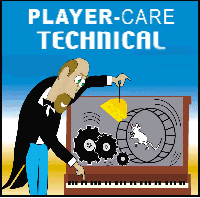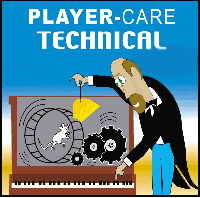
|

|

|

|

|

|
| Home | Manuals | Supplies | Search | Consult | Contact | Testing | Service |
Parts/Supplies (click) Technical Manuals .. (click here) Test your 'Player'.. (click here)


Tips and Tricks |
|
I recently wrote to a fellow technician and said, "Another Achilles' tendon (or weak spot) of the modern Aeolian player piano is the air motor. Even if the bellows cloth is in good shape and the sliding valves seat well, the wood itself typically 'seeps' (or leaks) so badly that overall performance suffers significantly. The only cure is to seal every interior surface repeatedly with a product like Phenoseal." While sealing the internal vacuum channel is not very time consuming, failing to do it correctly can contaminate the face of the block. If that happens, the block must be resurfaced, and that is time consuming and therefore costly. Also, if there are relatively major cracks in the channel, the Phenoseal can leak out and get onto the bellows, and that will cause them to harden slightly when the Phenoseal dries, causing the motor to 'lope'. To find out if there is internal leaking in the vacuum channel, remove the six slider guides and the five sliders. (Be absolutely certain to mark them so they can be put back EXACTLY where they came from -even the screws). Now you see the ten oval holes. The bottom five lead to the five bellows. The top five lead to the vacuum channel. Cover the five top holes with duct tape, making certain they are well sealed. Now suck on the vacuum supply flange. It should be like trying to suck the air out of a Coke bottle. In other words, it should be 100% air tight. Most likely it isn't. In fact, more than likely you will be able to suck air in as fast as breathing. (Now is also a good time to check the integrity of the bellows. Since the connecting rods are still connected to the camshaft, all you need to do to check each bellows is to place the fleshy part of a finger over the associated hole -leading to the bellow- and rotate the camshaft so the bellows is 'sucking'. In a perfect world, you will not be able to rotate the camshaft, which indicates that the bellows, its seal to the block, and the air channel leading to the sliding valve are all 100% air tight. If there is leakage, it's time to completely rebuild the motor. There is no adequate or long term "quick fix" for leaking bellows.) If there are major cracks in the internal channel, you might be able to hear a hissing sound. If that's the case, you can probably blow into supply flange and feel or hear where the air is coming out. (Although I don't advocate smoking, blowing smoke into the vacuum channel is a way to "see" where the air is escaping. However, seeing where the air is escaping is really unnecessary unless you need to prove to someone - like a customer - that there are indeed leaks.) To seal the channel, you have to pour Phenoseal into the channel through the vacuum supply flange. This can be tricky and messy, and, depending on the severity of the leakage, can become an instant nightmare. Therefore, I recommend that you first pour a relatively small amount of the sealant into the channel to see what happens. I also recommend that you situate the motor so that the block is facing the floor. This is because the cracks in the block are most often located on the back side, where the bellows are mounted. And, if that is the case, and the cracks are relatively severe, the Phenoseal will come running out of the cracks almost immediately, and it will get all over the bellows. Should that happen, you had better have an air compressor close at hand to blow off as much of the Phenoseal as possible as quickly as possible. Point being that a very thin layer of Phenoseal on the bellows will not cause a problem. A thicker layer will cause the motor to lope slightly once it dries. Keep filling the vacuum channel until it is full. Then pour the used Phenoseal back into a cup or jar. DO NOT pour it back into container with the fresh Phenoseal. Position the motor so that the excess Phenoseal can run out of the supply flange for a few minutes. Then turn the motor so that the face of the block is facing upwards - towards the ceiling - and hold it there for 15-20 seconds. Then rotate the motor so that the excess sealant again flows out of the supply flange. What you are attempting to do is to get out the sealant that gets into the area between the vacuum supply channel and the face of the block. Once you feel that the majority of the sealant has dripped back out, position the motor at about a 60 degree angle, face up, with the supply flange pointing towards the floor. Then carefully remove the duct tape, taking caution to avoid getting any of the sealant onto the face of the block. Use a Q-Tip to remove any sealant that is right at the top rim of the vacuum holes. Then allow the sealant to dry thoroughly for 36-48 hours. (After an hour or so, you can speed the drying process by using a blow drier, but as with everything in life, patience is a virtue that is desired by many but possessed by few.) DO NOT attempt to test the motor again until you are certain that the Phenoseal has thoroughly dried. Doing otherwise will 'undo' or 'break' the seal, and the whole process will have to be done over again. With any luck, the vacuum channel is now 100% air tight. However, the only way to insure that is to test it again. If you aren't lucky and leakage still exists, repeat the sealing process again, but do it very quickly. In this case, what quickly means is seal the holes with tape, fill up the channel with sealant, and pour it right back out. Do not leave the sealant in the channel for more than a few seconds. Reason being that the fresh sealant will have a tendency to 'melt' the already dried sealant, making it more difficult to seal the remaining leaks. Once the vacuum channel is 100% air tight, then the sliders (sliding valves) can be checked for air-tightness. Generally, they aren't air-tight either. Aeolian made the mistake of using young wood to make the block and sliders, and as the wood dries, it warps slightly, creating valve leakage. If that turns out to be the case, the block and sliders have to be resurfaced, and, as mentioned above, that is a time consuming and relatively costly job. |
|
Since "Player-Care" is an internet business, I prefer that we correspond via E-Mail (click here to fill out the 'Request Form'). However, if I'm not in the middle of some other activity, you can reach me at 732-840-8787. But please understand that during the hours from 8AM-5PM EST (Mon-Sat), I'm generally quite busy. So, I probably won't answer the phone. If you get the answering machine, please leave a detailed message stating the reason for your call. Also, repeat your name and phone number clearly and distinctly. By necessity, I prioritize everything in my life. And, if you call and just leave your name and number, and ask me to call you back, it might be a day or two before I return your call. Why? Because I don't know why you want me to call and I might not be prepared to assist you in an effective and efficient manner. If you leave me an E-Mail address (which I prefer), spell it out phonetically. The more you do to help me, the more I can help you in return. Don't rush. You have four minutes to record your message. |
|
407 19th Ave, Brick, NJ, 08724 Phone Number 732-840-8787 (Voicemail Only, No Texts) |
